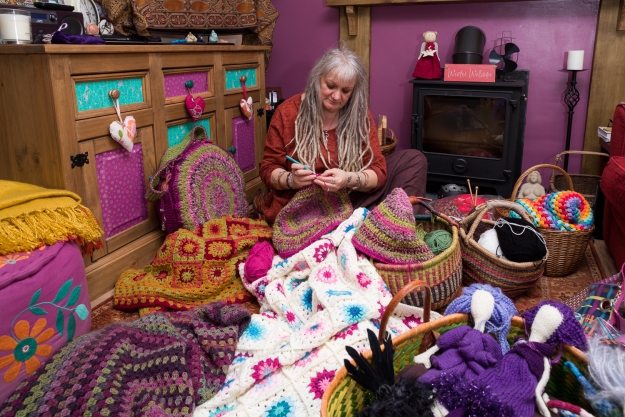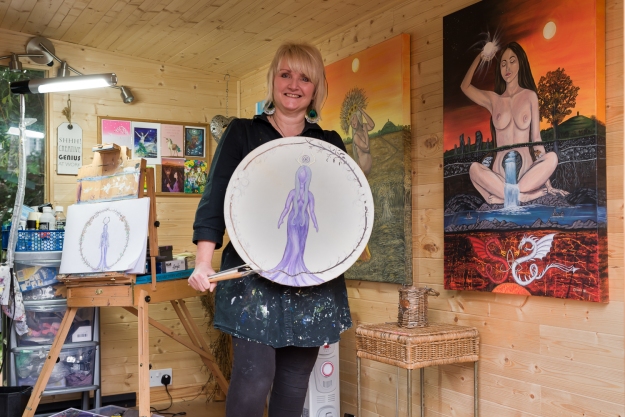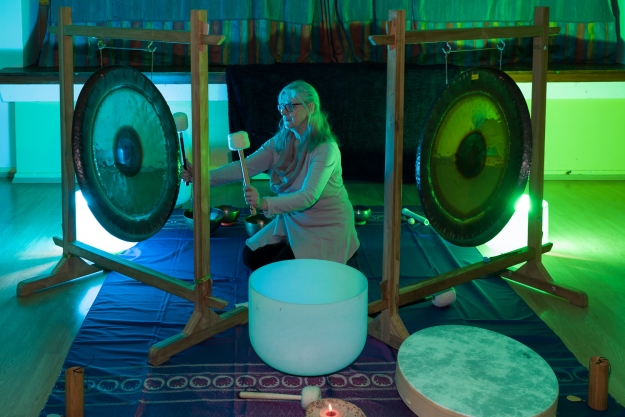
Commentary
People are increasingly turning away from mainstream religion and are defining their own unique spiritual paths through an uptake of Buddhist and Hindu practices such as mindfulness and yoga. One of the fastest growing spiritual paths in the west is now actually paganism, as people seek to rediscover the native sources of inspiration perhaps followed by our Druid and Norse ancestors.
As people find new spiritual identities, the concept of a spiritual place is also changing dramatically. Until recently the term would only be used to describe buildings such as churches and mosques. However an increasing number of people would now describe nature, an historic site or even their home as their personal ‘church’.
In this assignment I wanted to explore the identities of these people. Not as freaks or social curiosities, but a celebration of their authenticity – daring to be who they truly are in a western society ruled by convention and traditions. I discovered that for some of these people, forging their own meaningful spiritual path meant major life upheaval and sacrifice. I also wanted to explore the relationship between these new-age spiritual seekers and their special place.
My approach to the work was to purchase an advertisement on social media, asking for volunteers who would be prepared to be photographed for an art project depicting them practicing their spiritual path in a place important to them. A strong and diverse response allowed me to select from a range of people. However a major logistical challenge lay in being able to combine the demands of a full time job with travel to locations around the UK and meeting the Assignment deadline. The work presented here is therefore only the start and has opened the door to a longer term personal project.
With the exception of the first image (Glastonbury Tor) which contains a personal reflection, in each case my approach was to interview the subjects beforehand and learn about them, their own spiritual paths and special places. They each played a major role in defining the shot as I wanted all aspects of it to reflect their authentic self. I guided them on pose, gaze and position in addition to selecting the lighting and composition. They chose the location, props and clothing.
For example, the Priestesses of Avalon were keen to show how their chosen path allowed them to be strong, independent women within a spiritual community. I therefore included two people in this image to suggest the power of relationships. Conversely, the Druid found his inspiration alone in nature; the Pagan artist in her riverside studio surrounded by her previous works.
In conclusion, the work sets out to provide a glimpse into how people are finding their true identities in the very diverse spiritual paths found in Britain today. It aims to portray the deep relationship between them and the places that inspire and empower them to be their authentic selves.
Images

Pilgrims and seekers, Glastonbury Tor

Mandi. Sacred Crafter. Somerset

Steve, Ovate Druid, Doll Tor Stone Circle, Derbyshire

Elaine, Pagan Artist, Staffordshire

Tesesa, Sacred Sound Bath, Slitting Mill

Janet and Dawn, Priestesses of Avalon, Glastonbury Goddess Temple

Sarah, Moon Mother, Derbyshire
Reflection and Self Assessment
| Demonstration of technical and visual skills (40%) Materials, techniques, observational skills, visual awareness, design and compositional skills. |
All the images are tied together cohesively by being in a landscape format (despite being portraits). As well as keeping the frame dimensions consistent for the set, this subtly reminds us that there is more than just a portrait here – the landscape it is set in is just as important to the subject’s identity. To decide upon the sequence of the images I printed all of them as small 5×7 proofs then spread them on a table. This allowed me to play with various combinations.I did consider whether the ‘Pagan Artist’ fitted aesthetically with the rest of the set but decided to keep it in. This is because the whole point of the work is to show diversity. If some seem not to ‘fit’ with the rest then that is exactly how these people are in real life! The rhythm of the set is supposed to change with each image – dark, light, muted, bold, inside, outside. Given more time I would have liked to have included another image of a lady called ‘Ellen of the Ways‘ who lives in woodland and wears stag antlers to connect with her spirit energies. But the journey to the Scottish Highlands where she lives was not possible in the timeframe I have available to me. As described under ‘Demonstration of Creativity’ I had to pre-plan various combinations of lighting – including the use of coloured gels on off-camera flash – to portray a sense of how the environment is perceived by the subject. In contrast to the creative lighting used in some, the Druid is shot with very natural lighting, echoing his connection to the natural world and trees around him. I consider that the real test of success for this project is whether the subjects like the images and feel that they reflect their spiritual identity well. I’m pleased that all have been very well received with the Sacred Sound Bath lady declaring that ‘it is the only photo of myself that I like!’
|
| Quality of outcome (20%) Content, application of knowledge, presentation of work in a coherent manner, discernment, conceptualisation of thoughts, communication of ideas. |
I’m less satisfied in that I would like to have done more. However, the demands of full time work and logistics of travel are limiting the pace at which I can get the photographs. This is compounded by bad weather, travel and the onset of Christmas holidays, meaning that prospective subjects are now unavailable. I do intend to continue this as an ongoing personal project. The project required a lot of preplanning. I was very glad that I got to know the subject, planned the shot then arrived with a clear plan and the right photographic gear. In some cases I tested lighting setups at home in advance to save time with the subject. One required a long walk and so carrying everything ‘to be on the safe side’ was simply not viable.For several of the shots I used a tripod even though this was not technically necessary. This allowed me to fix the composition and focus on staying engaged with the subject. I found this to be a great help and will definitely do it again. This was a tip provided to me by my tutor in the feedback from Assignment 1. The First image suggests that the viewer may wish to come with us on a journey to see something new and spiritual. It invites the viewer to consider that some places are pilgrimage locations rather than just tourist attractions. What are people seeking? What are they searching for? The image also introduces the visual cue of a ‘path’ to echo the spiritual paths we will explore. The final image, Moon Mother, looks out of frame to the right and towards the setting sun. The moonlight is behind her, supplemented by flash (the image was actually taken on a full moon). It therefore symbolises the end of something and the start of something else, finishing the set of images in a logical manner. See the further comments above regarding selection and sequencing. For Assessment, the images will be printed A4 and presented as physical prints.
|
| Demonstration of creativity (20%) Imagination, experimentation, invention, development of a personal voice. |
In this work I’ve tried to bring a fresh and interesting angle to the primary themes of the course: ‘identity’ and ‘place’. I have not seen this aspect of spirituality explored in journals such as the British Journal of Photography before (the closest being Tomasso Fiscalletti’s study of Shamanic Practitioners in 2016; http://www.bjp-online.com/2016/10/photographing-shaman-women-in-south-africa/#closeContactFormCust00) Possibly the most creative image is The Moon Goddess. This shot attempts to portray the transient and illusive qualities of moonlight by using a very long exposure combined with flash. The off-camera flash was fitted with a pale blue gel to simulate the moonlight. I then asked the model to move out of shot before the end of the exposure, allowing a small amount of the background to show through her cloak, creating that ethereal, ghostly aesthetic to the image.For the Sacred Sound Bath, I wanted to create a sense of being in a tranquil ‘bath’. To create this effect I hid two off-camera flash heads fitted with green and blue gels behind the gongs. A third flash was set up to provide some fill light from the camera. I balanced the three manually using a light meter before taking a test shot. The Priestesses of Avalon are lit by a single flash head fitted with a brolly. They were celebrating Samhain (Hallowe’en) at the time which marks the influence of the dead ancestors on our lives. Combining this lighting with the temple background I sought to show both light (for the living)and shadow (for the dead) as a metaphor for their beliefs at this time.
|
| Context (20%) Reflection, research, critical thinking(including learning logs). |
Diane Arbus has been a major inspiration for this project in the way that she was able to win the confidence of individuals from more eclectic sectors of society and help them to feel positive about themselves in front of the camera. It would be easy to make the subjects feel like freaks in front of the camera if not approached and photographed sensitively. I’ve sought to follow a similar path here, identifying people with less than conventional spiritual paths and celebrate this rather than denigrate them.In practival terms this meant befriending them beforehand, talking sincerely about their path with empathy and understanding before even bringing a camera long. Some of these people reported to have suffered ridicule in the past for their beliefs and they wanted to be assured that this was not going to happen here. |
Contact Sheets










